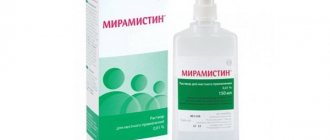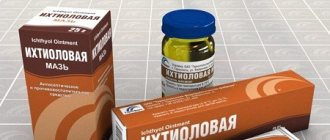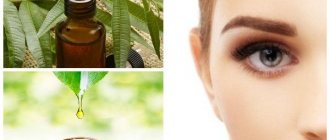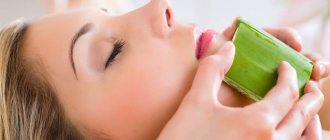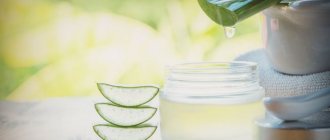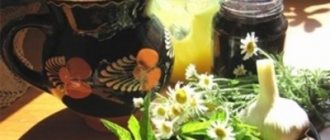To have clear, beautiful skin, you don’t have to spend a lot of money on expensive products and procedures. Grandma's time-tested recipes have proven themselves to be excellent. One of the popular sources of beauty and health is aloe. Many cosmetic companies produce products containing the extract of this plant. Aloe is often used for acne.
Related articles:
How to properly care for aloe at home What types of aloe are there: photo How to properly propagate aloe at home Where is aloe juice used? Using aloe juice for hair care
How to get rid of acne with aloe
If someone is interested in how to remove acne using agave, then the answer may be with a large number of recipes. For dermatological problems, this remedy is used in different ways. For example, wipe the skin with juice, or use it in combination with other products.
- The easiest option for treating acne is rubbing it with juice, which is squeezed from the leaves.
- You can also wipe your face with pieces of peeled leaves.
- Another good way is to rub cubes of frozen agave juice.
Making ice cubes from aloe juice
The procedure is performed twice a day: morning and evening, paying special attention to problem areas.
Using this principle, you can treat not only acne, but also herpes.
Aloe juice for acne. What is its use
Aloe juice , which helps get rid of acne , has various beneficial effects. And they all have a great effect on the condition of the skin. Therefore, it is so important to know why this plant is so useful.
This plant contains a large amount of vitamin C, as well as B vitamins, which have a positive effect if a person suffers from any skin diseases, including comedones, acne or even nodular cystic acne. In addition to these vitamins, the plant contains many microelements, amino acids and some other substances, thanks to which aloe juice has only a positive effect on the skin. The main actions should be considered:
- Antibacterial. Many people know this effect leaves against acne Juice is able to neutralize many microbes that cause those same hated acne.
- Anti-inflammatory. The juice is very easily absorbed into the area of inflammation, after which it almost instantly neutralizes redness.
- Regenerating. Why else does aloe help with acne ? Because it is able to push cells to grow and divide, which has a good effect on the condition of marks and numerous scars on the face, which so badly spoil the appearance and are the cause of complexes.
- Protective. When it comes into contact with the skin, this juice forms an invisible protective film on its surface, which has the same protective effect against all sorts of harmful environmental influences.
And finally, pus will be pulled out of even the largest pimple in just a couple of applications, if, of course, everything is done correctly.
And using the plant at home is as easy as shelling pears. Besides all this, this juice rejuvenates, nourishes, cleanses and tones, and it costs mere pennies. And in some cases, the medicine can be obtained literally at home, just by picking a couple of leaves of this plant.
Other recipes
Whitening lotion
A very popular lotion is made from aloe and cucumber, which whitens the skin. Its effectiveness is evidenced by numerous reviews on forums on the Internet of people who have tested this drug.
He prepares like this. Mix half a glass of olive oil and the same amount of heated almond oil. To this add the same amount of fresh aloe pulp. Add juice from one cucumber to the resulting mass and mix everything. Then everything is filtered and poured into a glass container. The finished product can be stored in the refrigerator for up to three months.
Compress for large pimples and boils
Sometimes pimples reach large sizes, which becomes a cause for serious distress. But, you need not to be upset, but to act, especially when there is such an excellent helper as aloe.
For a compress, mix olive oil and fresh juice from aloe leaves in equal proportions. A gauze pad is soaked in this mixture and applied to the problem area for 24 hours. This napkin must be changed every day. The pus is quickly drawn out of the boil and it disappears.
To enhance the effect of this procedure, you can wash off the applied mixture with tar soap.
Recipes: how to prepare the product at home and use it?
Below are a few recipes that contain aloe and help in treating acne.
For subcutaneous acne
To get rid of subcutaneous acne, a lotion made from aloe juice is well suited (all recipes for aloe lotions can be found here). For it you will need:
- 40 ml aloe juice;
- 10 ml salicylic acid;
- 50 ml water.
Mix all ingredients and wipe the skin twice a day for a week.
From ordinary
A tincture of aloe pulp will help with ordinary acne, for this:
- Separate 2 tablespoons of aloe pulp and grind to a puree.
- Pour in 300 ml of vodka.
- Leave for 5-7 days in a warm, dark place.
- After this time, take out the tincture and strain.
Apply the resulting lotion to spot-clean pimples for 5 days.
Cosmetic ice for skin
Cosmetic ice based on aloe juice can help tighten and firm the face, as well as get rid of acne.
To make ice you need:
- Separate two tablespoons of aloe pulp.
- Pour in 300 ml of warm water.
- Allow to cool to room temperature.
- Pour into molds and freeze.
Rubbing with ice has many beneficial properties, and aloe enhances the effect.
For age spots and acne on the face
To get rid of age spots, you can also use aloe pulp, for this:
- Apply the pureed pulp to problem areas.
- Rub into skin with light massage movements.
- Remove excess pulp with a napkin (lightly, so that the pulp does not fall from your face).
- Leave on skin for 40 minutes.
- Rinse off with warm water.
The procedure is carried out twice a day for a month.
Mask
A complex mask with an anti-inflammatory effect.
To prepare you need:
- Mix 1 tablespoon of aloe juice, chopped oatmeal (or flour), olive oil and honey.
- Apply to face for 20-25 minutes.
- Rinse off with warm water.
The mask can be used 2 times a week.
Preparation of raw materials
Proper preparation of raw materials is very important. At this stage, a base is formed, the basis of a useful mixture or mask. The main thing here is to choose the right leaves.
There are several simple rules for selection and preparation:
- You need to choose the thickest, fleshiest leaves, slightly dried out at the ends, but without visible damage. There should be no signs of rotting;
- To obtain the most beneficial juice, the plant should be stopped watering 10 days before cutting;
- Leaves must be cut off near the stem, closer to the ground;
- Rinse with plenty of warm, running water;
- Dry;
- Wrap in paper or cotton cloth;
- Place in the refrigerator for 10 - 14 days. Leaves should be placed so that they are as far away from the freezer as possible;
- After the required period has passed, the leaves must be removed;
- Throw away those that have shriveled or darkened;
- Rinse others again, remove thorns and thick skin;
- Squeeze thoroughly until the juice releases. You can squeeze it manually or using a meat grinder.;
- Be sure to strain the juice through cheesecloth;
- Pour into bottles, preferably dark glass;
- Store in the refrigerator or in a cool place away from sunlight;
- The juice retains its beneficial properties for 10-14 days, so it should be used as a medicine against acne as quickly as possible.
The juice must be prepared no later than 3 hours after unloading the plant leaves from the refrigerator. When using a meat grinder, the primary mass should be put in the refrigerator for an hour and a half and only then squeezed out, and through double gauze.
This way you can get biostimulated juice, which is much healthier for the skin.
Contraindications
It is generally accepted that contraindications to the use of aloe apply only to the internal use of preparations based on it, but external use in masks or as rubs can also have its consequences.
Before starting a course of treatment with aloe juice, it is recommended to be examined by an allergist , who will help find out whether a person has an individual intolerance to the juice of this plant.
Also in rare cases, allergic reactions are possible .
This remedy is completely contraindicated for people with oncology: aloe juice cannot be used for benign and malignant formations in the layers of the epidermis.
If there are no such problems, there is always a possibility that aloe juice may cause discomfort and irritation . In such cases, it is not necessary to refuse to use aloe juice, but it is better to reduce its concentration in the above recipes to a level at which such sensations do not occur.
Universal remedy with aloe for acne
Homemade recipes may contain ingredients that cause allergies (honey, herbs). This becomes the reason for refusing to use alternative cosmetics.
But among the numerous recipes there are also universal ones, containing hypoallergenic components and suitable for any skin type.
- In highly carbonated mineral water (50 ml) dilute 2 tbsp. l. Sabura.
- Add 3 drops of hydrogen peroxide to the solution.
- The composition is applied to the skin twice a day.
It is better to take medicinal-table mineral water, for example, “Essentuki 17”.
Contraindications for use
Like other medicinal products, the use of aloe juice in cosmetic procedures has its contraindications. There are not many of them, but they still exist. They are:
- This type of treatment is not suitable for people who have unexamined tumors on the skin.
- This plant should not be used if there is an individual intolerance to it.
Like other folk remedies, aloe should be used carefully so as not to cause an allergic reaction. Aloe juice for acne on the face will not lead to unpleasant surprises if you first conduct a mini-test using the standard test on the wrist.
Do you know that aloe for facial acne is one of the most effective anti-inflammatory agents, as it has medicinal and cosmetic properties? Find out as much as you can about the benefits of this plant. You can buy a ready-made cream with its extract or make a homemade mask.
What beneficial properties does aloe have for the skin?
The plant contains a large number of useful substances:
- essential oils;
- amino acids;
- organic acids
- vitamins (A, B, C, D, E);
- beta-carotene;
- cellulose;
- aloin;
- catechins (flavonoids that protect against allergies);
- carotenoids (organic pigment that protects complexion);
- pectin;
- antioxidants;
- trace elements (iron, manganese, zinc and others);
- mineral salts;
- tannins.
Thanks to them aloe:
- cleanses the skin;
- removes harmful toxins;
- soothes and extinguishes redness;
- relieves itching;
- disinfects;
- softens;
- nourishes and moisturizes, eliminating dehydration;
- makes the skin more elastic and prevents the appearance of early wrinkles;
- favors the production of elastin and collagen;
- improves complexion;
- mattifies the skin.
Aloe juice is most often used, although some beauty recipes say that you can also use the pulp of the leaves, for example, you can grate the leaf or grind it through a meat grinder.
Aloe juice is a powerful antibacterial, antiseptic, anti-inflammatory and cleansing agent, and the juice is an excellent wound-healing and antimicrobial drug.
How does aloe affect the skin?
The effect of aloe preparations on the skin has been studied in numerous scientific and clinical studies. Their results allowed scientists to conclude that the product provides:
- Wound healing effect;
- Anti-inflammatory;
- Antibacterial;
- Painkiller.
The most pronounced is the regenerating effect. Aloe promotes faster healing of skin wounds. Back in 1984, the American scientist I.E. Danhoff, working at the Texas Science Laboratory, conducted a large-scale study with his team, which found that aloe vera juice accelerates the formation of fibroblasts in injured areas of the skin by 6 times.
The site of a squeezed pimple is, in fact, the same injury, only in miniature.
It has also been confirmed that the drug exhibits antibacterial activity against staphylococcal, streptococcal and several other types of bacteria. When used externally, its effectiveness corresponds to synthetic drugs.
Aloe also provides an anti-inflammatory effect and a local anesthetic. These properties of the drug manifest themselves rather weakly.
In folk medicine, aloe is credited with much more effects, however, without scientific evidence, they remain only speculative.
Rubbing your face with leaves
For wiping, only fresh and peeled leaves of the plant should be used. It is not recommended to store cut leaves in the refrigerator for more than three days, as they lose their beneficial properties.
They are also applied as applications to inflamed areas and left to act for half an hour. This product can be used daily for 2-3 weeks.
In what form should I use aloe?
There are many opinions on this matter that are very difficult to compare. Some experts say that it is necessary to use aloe pulp for acne in a settled form, while others recommend fresh aloe juice for acne. In fact, it would be most correct to use fresh aloe to treat acne, since only within a few hours after cutting the leaf, aloe can show its maximum effect. In the following hours, the effectiveness of the plant, its pulp and juice, noticeably decreases. It is recommended to defend aloe only for the preparation of special products.
Since we are treating acne and we need the maximum effect on the skin, both bactericidal and anti-inflammatory, it would be advisable to use fresh aloe.
Aloe leaves cut from an adult plant that has reached the age of three or more years have the greatest healing power. Young plants can be used, but be prepared for the fact that they will only partially show the expected result.
Aloe Concentration for Acne Treatment
There are practically no shortages in modern pharmacies, and it is very easy to find the drug that we need, if only we had the money to buy the medicine. In the multimillion-dollar assortment, there was also a place for dozens of preparations containing aloe, in which its concentration is 20-80%. These are ointments with aloe for acne, special lotions with aloe extract with a bactericidal effect, creams based on aloe juice for speedy healing of wounds, and so on. And what’s surprising is that even products with minimal aloe content do their job perfectly. This is where the question arises: what then can fresh aloe do for acne and acne marks? Perhaps it is necessary to put aside spending on imperfect medicines for a while and use aloe juice for acne? This decision seems very correct, because almost all the instructions for pharmaceutical preparations with aloe say that the products have a positive effect on purulent wounds, inflammation and irritation of the skin... but these are only products with aloe extract, we decided to use a fresh medicinal plant against acne.
The concentration of aloe in the preparation for a real effect should be at least 15-20%, no matter what product you use. At least that's what medical practitioners say. But, at the same time, many of them claim that such drugs achieve only an indicative effect, such as softening and nourishing the skin. We need to get to the deep layers of the epidermis in order to influence not only the external manifestations of acne, ulcers and inflammation, but also their causes, which are contained deep in the layers of the skin.
Pure aloe juice is able to penetrate exactly where we need it, and not only relieve inflammation and soothe irritation, but also stimulate the regeneration of affected cells, normalize metabolic processes, open skin pores and clean them. This seems to indicate that you can use aloe juice for acne.
How to make juice yourself
Before preparing the juice, the leaves of the plant are thoroughly washed or doused with boiling water. The raw materials are crushed in any convenient way, and the resulting pulp is squeezed through a bandage.
It is recommended to use the resulting aloe juice for the face against acne immediately after preparation. It cannot be stored. You need to wipe the juice all over your face, or add it to the mask.
Before using the product, it is recommended to thoroughly cleanse your face of impurities using a gel or foam cleanser. To get the best effect, it is recommended to steam the skin first.
Contraindications for the use of aloe
Aloe juice is absolutely harmless only if it is used externally. Even cases of allergies were not recorded.
If you use it internally, you need to be as careful as possible; it is better to consult a doctor who will give you a whole list of contraindications.
So aloe juice should not be used by those who:
- prone to allergic reactions;
- suffers from diseases that cause bleeding;
- has kidney or liver disease;
- has neoplasms on the epidermis;
- suffers from hypertrichosis (facial hair);
- has the pathology of telangiectasia (close location of blood capillaries to the surface of the skin).
Warnings and contraindications
In this section I will dispense with ardent praises and warn you against being overly enthusiastic about aloe. It does have a number of contraindications. You should not take either pharmaceutical or freshly squeezed juice orally if:
- hypertension and heart disease;
- severe allergic reactions;
- disorders of the blood clotting process;
- diseases of the kidneys, liver, gall bladder;
- gastrointestinal disorders;
- malignant formations;
- is strictly prohibited during the menstrual cycle and for pregnant women, because has an abortifacient effect.
Aloe vera (agave) and Aloe Vera are considered healing and beneficial. Tree sap is used for external use. Therefore, before using the plant, find out which species graces your windowsill.
When used externally, the juice has no contraindications. It is most often obtained from the Barbadenis variety. It has large wide leaves and a lot of pulp. It can be applied in diluted or concentrated form even to the skin around the eyes. Before using, I advise those who have allergies and problems with dry skin to be careful.
Benefits of aloe for the face
The plant is famous for its cleansing and bactericidal properties. It contains vitamins, enzymes, minerals, essential oils, etc. Aloe leaves are suitable for both dry and oily skin care. The plant affects the skin of the face as follows:
- tightens pores;
- deeply cleanses;
- draws pus out of pimples;
- has antibacterial properties;
- exhibits anti-inflammatory effect;
- heals wounds and lesions on the skin;
- moisturizes;
- tones;
- soothes the skin;
- fights the appearance of acne and age-related changes;
- gives the skin a healthy glowing appearance.
Therefore, aloe copes with many skin problems, and is especially useful for:
- skin rashes;
- dryness and flaking;
- age-related changes;
- greasy shine;
- enlarged pores.
There are many recipes for preparing facial cosmetics.
How aloe-based cosmetics are prepared and how they are used
To prepare aloe-based cosmetics at home, use juice from the leaves of the plant or pharmaceutical extract, which is sold in ampoules.
The effectiveness of such an extract is the same as the effectiveness of juice squeezed from the leaves yourself.
To make juice:
- Cut off the lower leaves of agave or aloe vera;
- Wash them under water;
- Carefully cut off the spines and peel;
- The resulting pulp, which resembles a transparent jelly, is cut into small pieces;
- Place it in prepared gauze, folded in several layers;
- Then the juice is squeezed out by hand.
Aloe juice is used both in pure form and by mixing it with other medicinal ingredients, for example, a decoction of calendula or chamomile. They also have anti-inflammatory and regenerating effects.
Aloe juice can be used in different ways. It can be applied to the skin using a spray in the morning and at night. You can also wipe your face with cotton pads soaked in juice. If you need to quickly heal the skin or remove traces of a pimple on the nose, you can make a lotion or compress. The lotions are made very simply: a cotton wool or a piece of soft cloth is moistened in the solution and applied to the skin. Keep them for 15-20 minutes. Compresses are prepared, as a rule, using some other components: honey, vodka and oils. People know a lot of different recipes.
On a note
Fresh aloe juice should be stored in the refrigerator and used within 2-3 days. When stored for a long time, it deteriorates and loses its beneficial properties.
It is not necessary to prepare the products at home; you can also use store-bought products. Aloe extract is added to many industrially produced cosmetics. For example, popular products are from the Korean brand Holika, which has created an entire line of aloe-based products for comprehensive skin care. Other companies offer similar products. They produce face masks, creams, tonics, lotions, soaps and other products. However, if you wish, you can buy at the pharmacy a cheaper ointment or liniment based on agave leaves. Their effectiveness in treating facial rashes will differ slightly.
Useful video: what kind of mask is recommended to prepare from aloe to remove acne
Useful video
If inflammation occurs on the skin, it needs to be removed. But the masks should be made from components to which you are not allergic, so the combination of protein and aloe is ideal. Protein dries the skin, aloe moisturizes and has healing and healing properties. The mask is suitable for any skin type, but if your facial skin is very dry, lubricate it with cream before applying the mask. The mask can be done 3-4 times a week until the desired result is obtained:
The use of aloe for acne is very convenient because it does not have any side effects. These properties are characteristic of almost all traditional medicine.
Aloe or it is also called “agagae” is rich in vitamins, minerals and microelements, and is widely used in the manufacture of various cosmetic products.
There is probably not a single person who has not heard about the healing properties of the plant. And their list is not small, these are:
- cleansing;
- treatment;
- antibacterial effect;
- removal of scars;
- scar removal;
- cleansing spots left behind by acne;
- comprehensive skin health.

